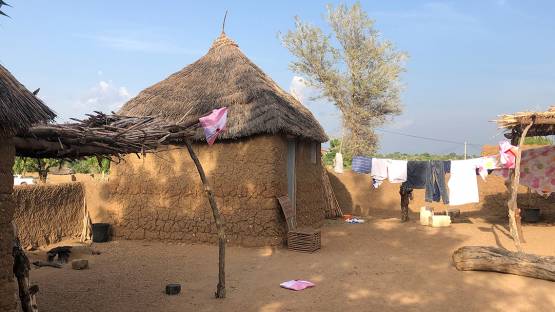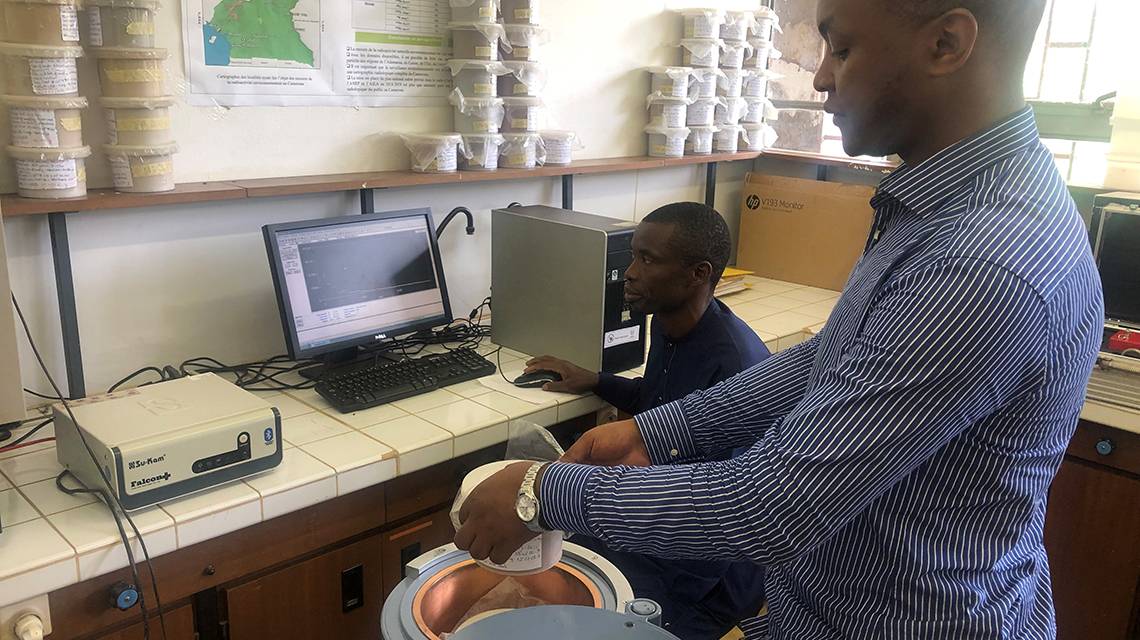Miklos Gaspar, IAEA Office of Public Information and Communcation
Aly Adams Diomande, IAEA Office of Public Information and Communcation

Several of the 3,000 homes – like these in the Northern Province – were surveyed in Cameroon for concentrations of naturally occurring radioactive radon isotopes. Almost 50% were found to have concentrations above WHO-established safety limits and residents were advised to ventilate their homes regularly as mitigation. (Photo: M. Gaspar/IAEA)
NGAOUNDERE AND YAOUNDE, CAMEROON – When Bobbo Hamadou gets up in the morning, he opens the door and window in his house. This is not just to air out his mattress – but to lower the concentration of radon in his home. He lives in one of the 150 dwellings in Ngaoundéré, found to have concentrations of this naturally occurring radioactive substance above the upper level recommended in IAEA safety standards and by the World Health Organization (WHO). Over a quarter of the houses surveyed in this city, capital of the Adamwa region, have high concentrations of radon.
“Dosimeters installed in my home enabled researchers to warn me that radon concentrations are high and that it is important to air out my home properly to avoid radon-related illnesses. Today, I air my house every morning and it has become part of my daily routine,” says Hamadou, who is the chief of a local district.
In a first of a kind pilot study in Africa, researchers at Cameroon’s Institute of Geological and Mining Research surveyed 3,000 dwellings across the country, including in areas that contain uranium deposits, where radon is often present at high levels. Over 2 per cent of the homes surveyed had radon concentrations above the upper IAEA recommended level of 300 Bq/m3, and a whopping 49 per cent were above the more conservative level recommended by WHO of 100 Bq/m3. Based on the data gathered – to be published in an article currently in press in the Journal of Radiation Protection and Research – the average radon level in Cameroon is 107 Bq/m3, versus the global average of just 40 Bq/m3.
“Our geology predetermines Cameroon for higher natural concentrations of radon, particularly in the north, south and west of the country, which are highly populated areas,” said Saidou, Chief of the institute’s Research Centre for Nuclear Science and Technology. The research was carried out with financial and technical support of the IAEA, along with other partners, including radiation protection institutes in India, Japan and Switzerland, which donated track detectors for measuring indoor radon levels.

Researchers at Cameroon’s Institute of Geological and Mining Research preparing a soil sample for test of radon concentration. (Photo: M. Gaspar/IAEA)
Radon accounts for around half of all human exposure to radiation from different sources, and inhalation increases the risk of developing lung cancer. Radon is the leading cause of lung cancer among non-smokers. Outdoors radon quickly dilutes to very low concentrations and poses no harm. On the other hand, even moderate concentrations of indoor radon pose health risks due to prolonged exposure. Chemical elements that decay into radon may be present in ground or soil, water and construction materials. See this Nuclear Explained article for more on radon.
Open the window, let radon out
Managing radon levels in a dwelling is not difficult – as long as the inhabitants are aware of the high concentration. Regularly airing houses, particularly bedrooms, is the most important in warm climates. For new construction, proper isolation of residential area from the ground combined with proper ventilation are the most important solutions.
But awareness building is a tall order in a predominantly rural country of 250 languages and cultures, Saidou said. “It’s hard for people to understand radon; it is even harder to convince them to allow dosimeters into their homes for the two-month measurement period required – many fear it is spyware or a bomb,” he said. Efforts now focus on finding funding to remediate the buildings where radon has been found as well as on increasing the sample size in order to be able to draw a fully representative map of radon levels in the country.
As the government is starting to hand out licenses for mining, creating baseline levels for concentrations of radon and thoron at future industrial areas is a new project Saidou is leading. “This is key to the country’s sustainable mining efforts,” he said.
A hub in Central Africa
For now, Cameroon is one of just a few countries in Africa to have begun mapping radon concentrations systematically. Neighbouring countries with similar geology are also taking notice. Current and former PhD students of Saidou’s are starting to carry out similar research in the Central African Republic, the Republic of the Congo and Gabon. Of the current batch of 1000 single use dosimeters donated by Hirosaki University in Japan, 600 will be used for pilot studies in these countries.
In Congo, research will focus on an area near a phosphate mine, where high concentration of radon was found in rocks, said Dallou Guy Blancbard, a former PhD student of Saidou, leading the research there. “People living near phosphate mining areas consume crops grown in these areas and also groundwater that are potentially contaminated,” he said. “Beyond the research, it will be important to make recommendations and implement awareness raising campaigns on the harmful effects of radon and how to mitigate these effects.”
Saidou is supporting the efforts in the Republic of Congo and is working to establish a regional centre of excellence on the topic, in collaboration with the IAEA. In the meantime, Hamadou is breathing more easily:
“This research saves life. More people should benefit,” he said.
No comments:
Post a Comment